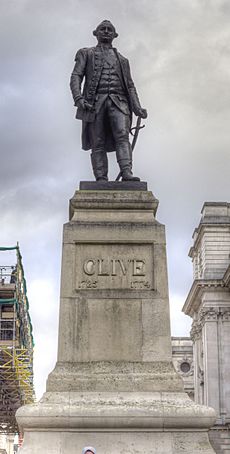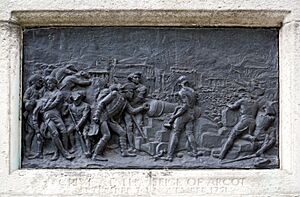Statue of Robert Clive, London facts for kids
Quick facts for kids Statue of Robert Clive |
|
|---|---|

The statue in 2010
|
|
| Artist | John Tweed |
| Year | 1912 |
| Medium | Bronze |
| Subject | Robert Clive, 1st Baron Clive |
| Location | King Charles Street, London SW1 |
|
Listed Building – Grade II
|
|
| Official name | Statue of Clive on steps at west end |
| Designated | 14 January 1970 |
| Reference no. | 1221431 |
A large bronze statue of Robert Clive, 1st Baron Clive stands on King Charles Street in Whitehall, London. It was created by the artist John Tweed and was first shown to the public in 1912. The statue was moved to its current spot in 1916. It is considered a Grade II listed building, which means it is an important historical structure.
What Does the Statue Look Like?
The statue shows Robert Clive standing tall. It is placed on a high base, called a plinth. On the front of the plinth, you can see Clive's last name and the years he lived (1725–1774).
The other three sides of the plinth have cool bronze pictures. These pictures show important moments from Clive's life. They include:
- The Siege of Arcot in 1751, which was a big battle.
- The time just before the Battle of Plassey in 1757.
- The Treaty of Allahabad in 1765, which was an important agreement.
The Story Behind the Statue
The idea for the statue started in 1907. Sir William Forwood wrote to a newspaper, The Times. He pointed out that there were no big monuments to Robert Clive in London or India.
Lord Curzon, a well-known politician, agreed. He helped start a special fund to raise money for memorials. They raised about £5,000 to £6,000 for statues in London and India.
However, the idea for a statue in India faced some challenges. The leader of India at the time, Lord Minto, thought it might cause problems. There was a lot of unrest in Bengal, India, where Clive had been the first British governor.
The artist John Tweed was chosen to create the London statue. He showed a small model of his design in 1910. The full statue was first shown in 1912 and then moved to its permanent home in 1916.
A smaller bronze version of this statue is now kept at the Tate museum in London. John Tweed also made other works about Clive. These include a memorial at Westminster Abbey and a marble statue at the Victoria Memorial in Kolkata, India.

Recent Discussions About the Statue
In the early 2000s, some people started to question the statue. Nick Robins, a writer, suggested that the statue should be moved to a museum. He felt it was important to think about Britain's past actions in other countries.
In June 2020, there were more calls to remove the statue. This happened during a time of many anti-racism protests. Some people felt that statues of historical figures linked to difficult parts of history should be re-examined.
Lord Adonis, a politician, asked the government to discuss the statue's future. The Mayor of London, Sadiq Khan, also ordered a review of public monuments in London.
Historians and writers like William Dalrymple and Afua Hirsch have shared their views. They believe the statue represents a complex part of history. They suggest it's important to understand why such statues were put up and what they mean today.



